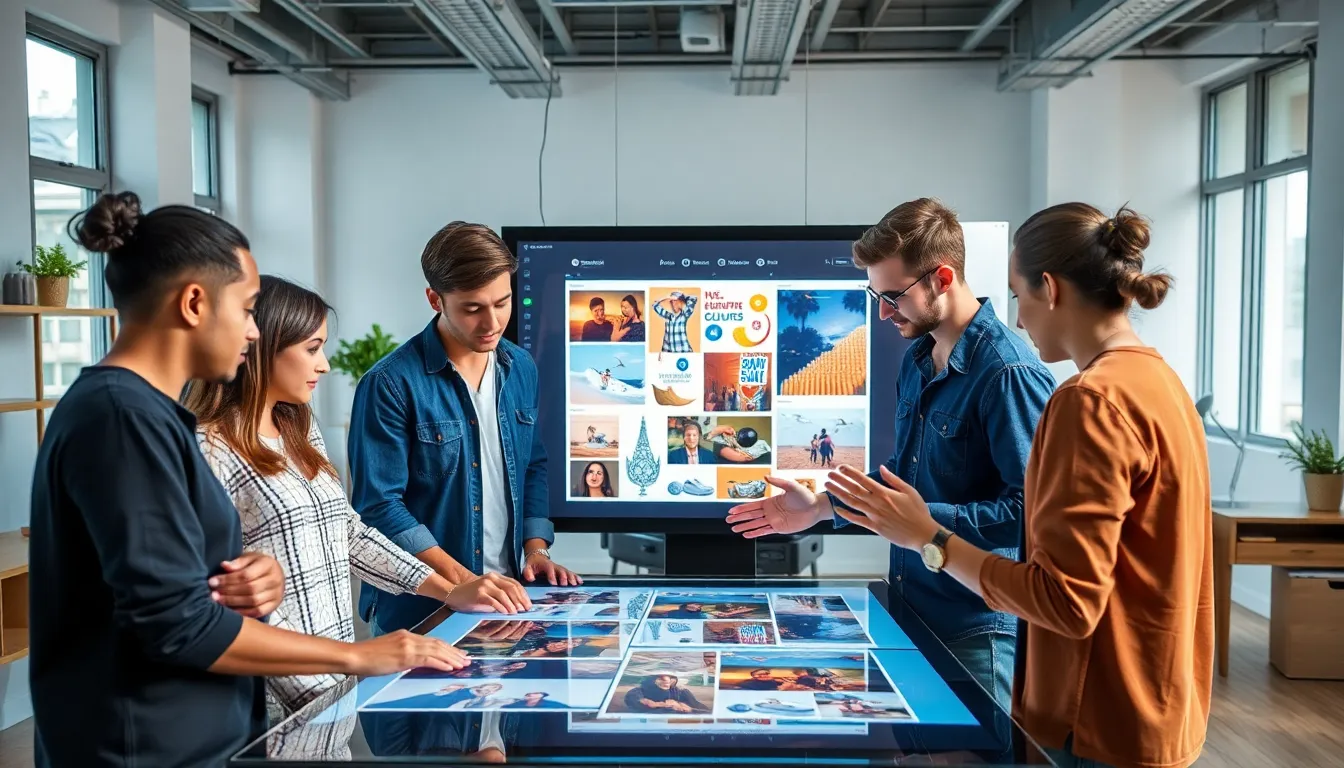In a world where attention spans are shorter than a cat video, interactive magazine design swoops in like a superhero, ready to save the day. Gone are the days of flipping through static pages that feel as exciting as watching paint dry. Today’s readers crave experiences that engage them and keep them coming back for more.
Table of Contents
ToggleOverview of Interactive Magazine Design
Interactive magazine design transforms traditional reading into an engaging experience. Readers enjoy dynamic elements like videos, animations, and audio within the content. This format enhances storytelling and captures attention better than static pages.
Designers prioritize user engagement by integrating interactive features. For instance, navigable layouts allow readers to explore articles in depth. Polls and quizzes invite audience participation, making each issue feel personalized.
Visual appeal plays a critical role in interactive magazines. High-quality graphics and responsive layouts adjust to various devices. This adaptability ensures a consistent experience across smartphones, tablets, and laptops.
Analytical data supports the effectiveness of interactive formats. Studies indicate higher reader retention and satisfaction rates with interactive content compared to traditional magazines. Engagement metrics demonstrate that users spend more time interacting with multimedia elements.
Publishing houses increasingly focus on interactive designs to attract advertisers. Advertisers benefit from enhanced brand visibility and consumer interaction within the magazine. This synergy creates a win-win situation for both readers and marketers.
Future trends point toward advanced technology integration in interactive magazines. Augmented reality (AR) and virtual reality (VR) are on the horizon, promising even more immersive experiences. As technology evolves, so does the potential for more innovative and engaging magazine content.
Key Elements of Interactive Magazine Design

Interactive magazine design incorporates several key elements that enhance reader experiences. Two primary aspects are visual aesthetics and user engagement, each contributing to the overall effectiveness of the format.
Visual Aesthetics
Visual appeal plays a pivotal role in interactive magazine design. High-quality graphics attract readers and encourage exploration of content. Engaging animations draw attention to key features or articles, guiding viewers seamlessly from one section to another. Color palettes and typography should align with the magazine’s brand identity while remaining accessible for diverse audiences. Responsive layouts ensure that visuals adapt fluidly across different devices, providing a consistent reading experience. Creative use of space also allows for innovative presentations of information, breaking from traditional grids.
User Engagement
User engagement drives the success of interactive magazines. Incorporating navigable layouts enables readers to explore content intuitively, enhancing the discovery process. Tools such as polls and quizzes foster participation, allowing audiences to express opinions and preferences, making each issue feel tailored. Providing opportunities for social sharing encourages readers to discuss content, creating a community around the magazine. Multimedia elements like video and audio enrich narratives, holding attention longer than static text. Data shows that these strategies significantly improve reader retention and satisfaction.
Technologies Used in Interactive Magazine Design
Innovations in technology drive interactive magazine design, enhancing reader engagement and experience. Several key areas contribute to the effectiveness and appeal of these interactive formats.
Digital Platforms
Digital platforms serve as the foundation for interactive magazines. They deliver content through websites and apps designed for various devices, including tablets and smartphones. Responsive design ensures that layouts adapt seamlessly to different screen sizes. Popular platforms like Issuu and Magzter allow publishers to distribute their magazines widely while offering interactive capabilities. Readers enjoy the accessibility of content, boosting overall engagement. Analytics tools integrated into these platforms provide valuable insights, helping publishers understand reader behavior.
Software Tools
A variety of software tools facilitate the creation of interactive magazine elements. Software like Adobe InDesign and Canva enables designers to develop visually appealing layouts and integrate multimedia features. These tools allow for easy incorporation of videos, animations, and audio files. Advanced editing software enhances image quality and allows for sophisticated animations. Collaboration features within these tools support teamwork among designers, editors, and content creators. This synergy results in a polished final product that captivates audiences and keeps them coming back for more.
Best Practices for Creating Interactive Magazines
Creating an interactive magazine involves several best practices that enhance reader engagement. Prioritize high-quality visuals; sharp graphics and vibrant colors attract attention and maintain reader interest. Incorporate varied multimedia elements; videos, animations, and sound clips enrich storytelling, providing depth beyond static text.
Establish intuitive navigation; a clear layout allows readers to explore content effortlessly. Implement interactive tools like polls and quizzes; these features foster audience participation, encouraging interaction with the material. Balance creativity with functionality; while unique designs captivate, usability remains essential for a seamless experience.
Engagement metrics should guide design choices. Use analytics to track reader behavior; understanding preferences enables fine-tuning of future issues to align closely with audience interests. Adapt layouts for multiple devices; responsive design ensures accessibility, promoting a consistent experience across smartphones, tablets, and desktops.
Consider the importance of brand identity; typography and color schemes should reflect the magazine’s values. Craft narratives that resonate; compelling storytelling captivates, keeping readers invested from start to finish. Continuously seek audience feedback; direct input helps refine features and content, enhancing satisfaction levels.
Finally, explore emerging technologies; new tools like augmented reality (AR) can offer innovative experiences that deepen reader engagement. Embrace the evolving landscape of interactive design; staying current with trends allows magazines to captivate readers and remain competitive in a digital-first world.
Case Studies of Successful Interactive Magazines
The interactive magazine National Geographic Kids demonstrates how engaging content captivates younger audiences. This publication incorporates vibrant visuals, quizzes, and videos that enhance the reading experience, making learning enjoyable. Readers interact with the magazine’s features, leading to increased retention of educational materials.
Another notable example is Wired Magazine, which leverages cutting-edge technology to present articles in immersive formats. The integration of interactive infographics and animations supports complex information, allowing users to explore topics at their own pace. Data shows this approach improves reader comprehension and satisfaction significantly.
The New York Times Magazine also excels in interactive design. It uses multimedia elements like audio narratives and interactive timelines to deepen storytelling. Each piece invites readers to engage with the content actively, creating a more compelling experience.
Vogue stands out through its blend of fashion and interactivity. The magazine features shoppable content, enabling readers to purchase items directly from the pages. This strategic combination increases both reader engagement and revenue through affiliate marketing.
The Atlantic has successfully incorporated interactive storytelling into its digital format. By using scrollable narratives enriched with visuals and videos, it enhances the reader’s journey through complex issues. Analytics indicate that this immersive approach keeps audiences engaged longer than traditional articles.
Collectively, these case studies showcase the power of interactive design in magazines. By utilizing multimedia elements and interactivity, these publications not only enhance the reading experience but also achieve higher retention and satisfaction rates. Focusing on engagement and visual appeal effectively draws readers back for more.
Interactive magazine design is revolutionizing the way content is consumed. By merging high-quality visuals with engaging multimedia elements, it captivates readers and fosters a deeper connection. The emphasis on user engagement through navigable layouts and interactive tools transforms reading from a passive activity into an immersive experience.
As technology advances, the potential for incorporating augmented and virtual reality into magazine design will only enhance these interactions. Publishers must embrace these innovations to stay competitive in a rapidly evolving digital landscape. Ultimately, the future of magazine design lies in its ability to adapt and engage, ensuring that readers remain invested and eager for each new issue.




